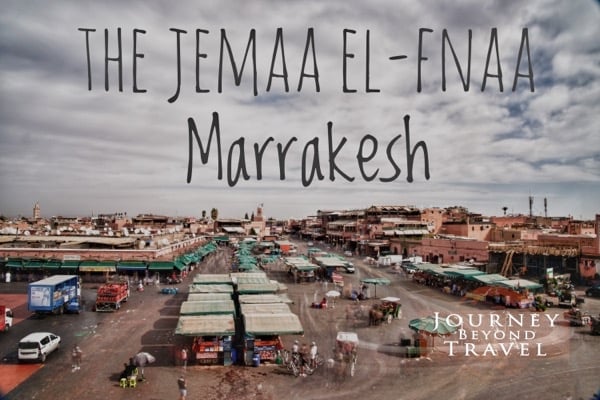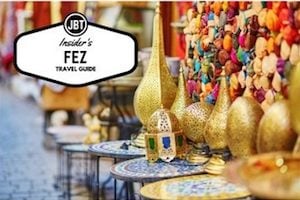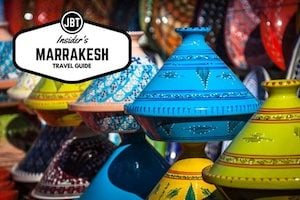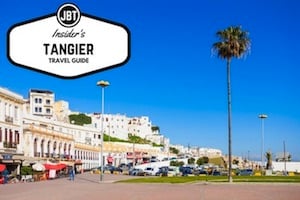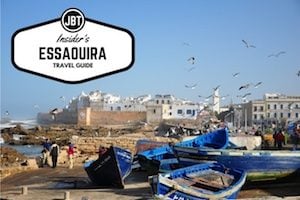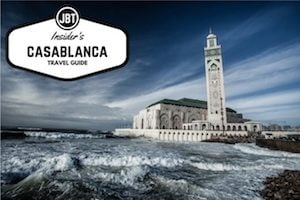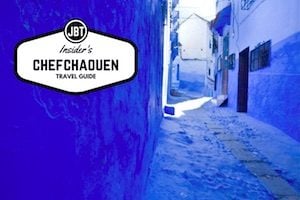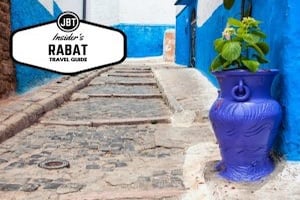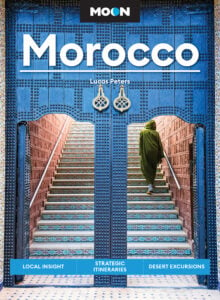The Jemaa el-Fnaa (also often: “Djema el-Fna” or “Jamma el-Fnaa”), is the historic main square of Marrakesh. It is a free and veritable outdoor theater that has existed for a thousand or more years. Any tour to Morocco would somehow be incomplete unless you spent an evening strolling through this incredible landmark to experience for yourself.
Marrakesh is one of Morocco’s largest and most popular destinations. It can feel a bit overwhelming if you’re wandering into the city for the first time, particularly if your first stop is the Jemaa el-Fnaa. I always recommend travelers get themselves well-rested and mentally prepared to indulge in what is perhaps the worlds longest on-going carnival! It seems that day-and-night, there is always something happening in this giant public square.

The History of the Jemaa el-Fnaa
The Jemaa el-Fnaa. What does its name even mean? Some translations have it simply as “The Last Square” or “The Place Where Everything Ends¨ or ¨The Mosque of the Square.” Some rather poetic, though likely false, interpretations have it as the “Assembly of the Dead” while others have it as the “Place of the Vanished Mosque.”
No one is sure of the exact meaning of Jemaa el-Fnaa, though many local guides believe the name refers to a lost Almoravid mosque, which was likely destroyed over a thousand years ago when the Almohad Dynasty took control of Morocco. The Almohads, in their turn, were responsible for the construction of the Koutoubia Mosque, located at the western edge of the public square.
Since about 1050 CE, the most important thing about this famed square is its relation to Marrakesh. Locals and visitors have shared this space for time immemorial. Water sellers, storytellers, musicians, snake charmers, monkey handlers, acrobats, fortune tellers, and many, many more have long greeted weary travelers coming from the Sahara and beyond with a smile and a performance sure to lighten even the most travel-hardened hearts.
The Jemaa el-Fnaa is impossible to miss. It is bordered by Rue Moulay Ismail and Rue Riad Zitoun el-Kedim on the west and east, respectively. To further orient yourself, it helps to know that the Place de Foucauld, Oessabin Mosque and Place Bab Fteuh are also near the square. Though of course, all you really need to do is look up at walk toward the Koutoubia Mosque!
When to Visit the Jemaa el-Fnaa?
The Jemaa el-Fnaa is not something that ever truly closes. You don’t have to worry too much about opening hours or closing hours the seasons or even admission costs! However, the rhythm and sense of what is is or what it might be does change throughout the day. At the break of down, it is noticeably quiet. Even performers need their rest. But soon after the first call to prayer, you can often find the first performers out and about.

Once the morning is in full swing, the Jemaa el-Fnaa transformers into a marketplace. You will find water sellers, orange juice stalls, makeshift barbecue grill restaurants, snake charmers, and fortune tellers about. Don’t worry too much about the snake charmers… you can easily avoid the snakes should you wish.
As the Moroccan sun warms into the often sweltering heat of the afternoon, the marketplace entertainment changes. The snake charmers leave and Chleuh dancing boys arrive on the scene. Storytellers share tales in Berber or Arabic; peddlers with medicines and magicians also become part of the entertainment.
The square becomes more crowded as evening begins to fall. More food stalls appear when night descends. Smoke from the many barbecue grills ascends into the starry night. Late into the evening, you will find traditional healers and dancers, singers and musicians, astrologers and acrobats all taking turns to light up the night. It is something special that only exists in Marrakesh.
The UNESCO Intangible Cultural Heritage of Humanity
The Jemaa el-Fnaa was proclaimed as a site of Intangible Cultural Heritage of Humanity by UNESCO, and finally Inscribed in 2008. It is perhaps the one thing most associated with any sojourn in Marrakesh. When one speaks of Marrakesh, one speaks of the Jemma el-Fnaa, of a night out on the square, of taking in this amazing display of humanity. The Jemaa el-Fnaa “represents a unique concentration of popular Moroccan cultural traditions performed through musical, religious and artistic expressions.¨
UNESCO of course has several World Heritage Sites in Morocco, some of which, such as the Roman Ruins of Volubilis, are very well known. However, it is these experiences they define as Intangible Cultural Heritage of Humanity that truly lend Morocco its unique charm. As is has been for nearly a millennia, the Jemaa el-Fnaa Square remains a major place of cultural exchange. In fact, the entire square has enjoyed a sort of protected status by the Moroccan government since 1922.

Of course, one of the reasons to be inscribed on the UNESCO Intangible Cultural Heritage of Humanity is because there are real threats to the continuation to something of cultural importance. What threatens the Jemaa el-Fnaa today is much like what threatens traditional ways of living all of Morocco. Unsustainable, mass tourism of course plays a part in this, as does the continued widespread use of smartphones, televisions, commercialism and the like. Urbanization is another threat, as is urban planning and road infrastructure.
For so many of these reasons, and more, this is why I believe being a sustainable tour operator and traveler is more important than ever! As mindful travelers, we have the power and can do our part to ensure these wonderful culture experiences will be here for generations to come.
The Best Way to Enjoy
The entire square is generally a very busy location. Scooters and pedestrians zoom back and forth, zigging and zagging through the masses. Curious travelers can spend more than a day just exploring this historic, amazing, carnivalesque public square. Consider breaking down your journey to the square into two trips.
Spend the first day around lunch time getting acclimated to the sights, sounds and activities found here. Look through the various shops, explore the souks, and determine what you might like to buy. Here is the secret: This first day, don’t buy anything! Save all the purchases for when you return on the second day to make your purchases. There are numerous wares sold at the souk, so it is possible to find another item you prefer over the first few things you see. The vendors will bargain on the price of their items. They expect this haggling and to refuse is an insult. Begin with a price you think is fair for the item and let your conversation determine the correct price. Never insult a vendor by offering a price that is too low for the quality of work.
The second day, head back just before evening. Notice the change in the environment. Spend plenty of time to soak it all in! Just before dinner, dive into the surrounding souks and head out on the square to make all of your purchases. Like this, your bargaining will have had an entire day to have the vendor consider an even larger “discount” for you. This night, consider dining out on the Jemma el-Fnaa. Pull up a chair at one of the many barbecues. Enjoy a feast and the spectacle that is the Jemma el-Fnaa. This is the original “dinner and a movie” experience!
Dining Out on the Jemaa el-Fnaa
It might seem overly touristy, but the food stalls in the Jemaa el-Fnaa actually existed long before tourism ever took root. The smoke from the grills wafting over the carnivalesque square is as familiar a sight to the locals as the nearby Koutoubia Mosque. Prices will fluctuate wildly depending on your negotiation skills. In principle, you should agree to a price for everything before eating. A typical meal costs 30-50Dh, and a plate of grilled meats large enough for 3-4 people to share can run 100-150Dh. Other options include a small bowl of snail soup (5Dh), harira (5Dh), and one of the most refreshing glasses of freshly squeezed orange juice you’ve ever had (4Dh).

Feel free to walk around the stalls and inquire about the food on offer; high-pressured sales are the name of the game, with everyone promising to feed you “the best” in Marrakesh, but it’s all largely friendly. Several stands have been featured in travel guides and on websites, though in practice, the food is pretty much the same across the board. The only real issue you might run into is the occasional owner trying to charge more for olives and bread, which are typically free, or having you pay for a full plate instead of half plate, though if you agree on a price ahead of time, this can be avoided.
The stands are controlled by the Moroccan government, so cleanliness is generally okay, though as a rule stick to the soups, fried foods, and meats, and stay away from the seafood or anything uncooked, as there are no refrigerators to keep food cold, and in the heat bacteria can be a problem if anything is undercooked. It might be a good idea to forgo the silverware, as it is often washed with the same water all day long; instead, eat with your hands. For sauces, use a piece of bread to scoop up your food, just like the locals.
NOTE: “Dining Out on the Jemaa el-Fnaa” taken from Marrakesh & Beyond, my deep dive into all things Marrakesh I penned and photographed for the Moon Guidebook series published by Hachette.
About the Author
 Text and photos by award-winning writer, photographer, and Morocco expert, Lucas Peters. Except for the last photo. That is a great shot by our own Amina Lahbabi! After spending years traveling to the distant corners of Morocco and writing about his adventures, Lucas penned the 1st and 2nd editions of the best-selling guidebook Moon Guidebooks: Morocco as well as Marrakesh and Beyond published by Hachette. He edited and contributed to the Our Morocco anthology and helps the travelers of Journey Beyond Travel experience the adventure of a lifetime. He lives in Tangier with his family.
Text and photos by award-winning writer, photographer, and Morocco expert, Lucas Peters. Except for the last photo. That is a great shot by our own Amina Lahbabi! After spending years traveling to the distant corners of Morocco and writing about his adventures, Lucas penned the 1st and 2nd editions of the best-selling guidebook Moon Guidebooks: Morocco as well as Marrakesh and Beyond published by Hachette. He edited and contributed to the Our Morocco anthology and helps the travelers of Journey Beyond Travel experience the adventure of a lifetime. He lives in Tangier with his family.

